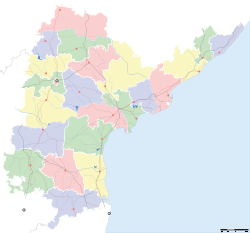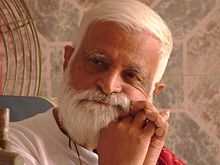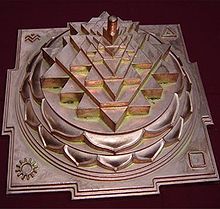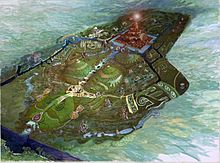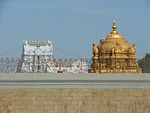- Devipuram
-
Devipuram 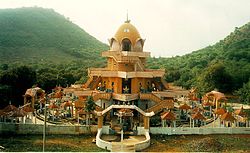
Sahasrakshi Meru TempleCoordinates: 17°45′55.32″N 83°4′58.64″E / 17.7653667°N 83.0829556°ECoordinates: 17°45′55.32″N 83°4′58.64″E / 17.7653667°N 83.0829556°E Name Devanagari: देवीपुरम् Sanskrit transliteration: Devīpuram Location Country: India State: Andhra Pradesh District: Visakhapatnam Architecture and culture Primary deity: Shakti as Sahasrakshi Architectural styles: South Indian Architecture Number of temples: 3 History Date built:
(Current structure)1985-1994 Creator: N. Prahalada Sastry Website: devipuram.com Devipuram is a Hindu temple complex located near Visakhapatnam, Andhra Pradesh, India. Belonging primarily to the Shakta school of Hinduism, it is dedicated to the goddess Sahasrakshi (lit., "she who has a thousand [infinite] eyes", a form of Lalita Tripurasundari or Parvati), and her consort Kameshwara (a form of Shiva).
Contents
Overview
Devipuram's primary focus is the Sahasrakshi Meru Temple, a unique three-story structure built in the shape of a Sri Meru Yantra; i.e., a three-dimensional projection of the sacred Hindu diagram known as Sri Chakra, which is central to Srividya upasana (an ancient and intricate form of Tantric Shakta worship). Measuring 108 feet (33 m) square at its base and rising 54 feet (16 m) high, the temple has become an increasingly popular pilgrimage destination over the past decade. Two other shrines, the Kamakhya Peetham and Sivalayam, are located on hills adjacent to the main temple.
The sanctum sanctorum of the Sahasrakshi Meru Temple is reached by circumambulating inward and upward, past more than 100 life-sized murthis of various shaktis or yoginis (deities expressing essential aspects of the Devi) who are, in Srividya cosmology, said to inhabit and energize the Sri Chakra. Their exact locations are "mapped" in an elaborate ritual called the Navavarana Puja ("Worship of the Nine Enclosures"), which was in turn condensed into a mantric composition called the Sri Devi Khadgamala Stotram ("Hymn to the Auspicious Goddess's Garland of Swords"), forming the basis of the temple's layout.
This temple is unconventional in its practice of allowing devotees to perform puja to the Devi themselves, without regard to caste, creed or gender.[1] This may be an emulation of the Kamakhya temple complex in Assam, which has the same open policy for worship. The fact that many of the temple's murthis are portrayed as "sky-clad," or nude, has also, over the years, gained Devipuram considerable attention.[2]
History
Construction of the Sahasrakshi Meru Temple in Devipuram began in 1985, and its completion and consecration (kumbha-abhishekam) took place in 1994. In accordance with Hindu tradition, the temple was re-consecrated for its twelfth anniversary in February 2007.
The founder of Devipuram is Dr. N. Prahalada Sastry (b. 1934), a former university professor and nuclear physicist who left a successful 23-year career with the Tata Institute of Fundamental Research in Mumbai to begin work on the Devipuram temple in 1983. Now a noted spiritual guru, better known as Sri Amritananda Natha Saraswati (and generally addressed as "Guruji"), Sastry reports that his creation of Devipuram was based on several visions of the Divine Mother, which specified both the design and mission of the temple complex. Each of the many murthis within the Sahasrakshi Meru Temple was individually sculpted to Sastry's specifications, physically manifesting his meditative visions of these deities.
According to Devipuram's official history: "In 1983, during Devi Yajna, Guruji was approached by the brothers of the Putrevu family with a request to build a temple for the Divine Mother. In addition to the 3 acres (12,000 m2) of land that they had donated, Guruji bought the adjoining 10 acres (40,000 m2) and it was registered as land for the Devi temple."[3] The history continues:
"Having acquired the land, Guruji was looking for divine guidance, a sign of approval to commence construction of the temple. In the vicinity of the donated land, there was a small hillock where Guruji would often spend time in meditation. On the slopes of the hillock, he noticed a formation [i.e., a cleft rock forming a natural yoni] very similar to that of the Kamakhya Peetam in Assam. One day while in meditation he experienced himself lying on the peetam [holy site], while four others performed a homa, with flames emanating from his body. And during purnahuthi [the final round of ritual offerings], he felt a heavy object being placed on his heart. Awakening from his meditative state, Guruji was prompted to dig that site. Unearthed from that very spot, he found a Sri Chakra Maha Meru made of panchaloha. It was later discovered that a huge yajna had been performed in that area more than 250 years earlier."[3]
Soon afterward, "Guruji had visions of the Devi as a 16-year-old girl. With her blessings, he built the Kamakhya Peetam on the hillock and a Siva temple on the peak in 1984. Construction of the Sahasrakshi Meru Temple in Devipuram was started in 1985."[3] A recent Devipuram publication reflected, "Even a fleeting glance at what has been accomplished around what used to be a no-man's land is enough to astound anyone." [4]
Mission & Activities
In addition to providing regular religious services and other spiritual functions, Devipuram produces and distributes spiritual aids (most specifically related to Srividya upasana), such as high-precision Meru yantras,[5] animated presentations, audio/video aids and other educational materials for spiritual aspirants.
Devipuram has also become a hub for spiritual and rural empowerment workshops and seminars. For this purpose, Sastry founded the Sri Vidya Trust, a not-for-profit, non-governmental organization headquartered at Devipuram. Through the trust, Sastry – along with other staff and volunteers at Devipuram – has undertaken a number of developmental initiatives focused on non-formal education, empowerment of women and low-cost housing for the rural poor. A cooperative thrift society, sponsored by the trust and called Jagruti, offers micro-financing services to local villagers. Low-cost, fire-retardant, geodesic dome-houses for pilgrims and other visitors have been erected at Devipuram, using appropriate technologies to demonstrate the viability of such designs in rural India. Devipuram has also conducted many rural empowerment programs in the surrounding countryside, relating to health, hygiene, family planning, literacy, energy generation and energy conservation. [6]
Future plans
In furtherance of Sastry's vision, Devipuram has ambitious plans to become a "global resource for goddess worship."[7]
In 2005, news reports noted that a spiritual retreat would be developed at Devipuram. Called Manidweepam ("Isle of Jewels," a name for the Mother Goddess's heavenly abode in Hindu scripture), the retreat "will contain 51 shakti peethas corresponding to the form of Devi's body, all within an area of 2.5 lakh [250,000] square feet." The retreat is slated for completion by 2010, and its "design includes centers of learning for spiritual arts and sciences, performance theaters and boarding/lodging facilities, all set in an enchanting array of gardens and groves. The first phase of the construction of Manidweepam is already underway in the form of 'Srivilla,' a beautiful residential complex." [8]
In 2006, Sastry installed a longtime disciple, Subbarao Kompella (also known as "Karunamaya Baba"), as the new head of Devipuram, in charge of the temple's day-to-day affairs; however, Sastry remains at the center of Devipuram's spiritual life. A souvenir booklet produced by Devipuram for the temple's 2007 re-consecration stated: "Known worldwide for his spiritual energy and ability to synergize people from diverse backgrounds to flow in sync with the Goddess's shakti, Karunamaya Baba has personally taken on the challenge of bringing Guruji's vision of Devipuram to fruition."[9]
References
- ^ Sri Amritananda Natha Saraswati (Guruji).
- ^ "Asian Age, "Nothing shameful about nudity."". http://www.asianage.com/presentation/leftnavigation/asian-age-plus/culture-plus/nothing-shameful-about-nudity.aspx. Retrieved 2007-09-08.
- ^ a b c Devipuram History
- ^ Devipuram Kumbha-Abhishekam Souvenir Magazine
- ^ Devipuram Merus
- ^ Sri Vidya Trust
- ^ "Telugu People, "Devotion: Guru Pournami"". http://www.telugupeople.com/discussion/multiPageArticle.asp?id=40770&page=1. Retrieved 2007-09-05.
- ^ " Devipuram to get a spiritual resort," The Hindu, July 13, 2005.
- ^ "Devipuram Kumbha-Abhishekam Souvenir Magazine". http://devipuram.com/mailables/souvenir.html. Retrieved 2007-09-07.
External links
Hindu Temples in Andhra Pradesh Adilabad Anantapur Veerabhadra Temple, LepakshiChittor Ardhagiri Veeranjaneya Swamy · Boiyakonda Gangamma Temple · Kanipakam Vinayaka Temple · Kapila Theertham ·
KonetiRayala Swamy Temple · Srikalahasti Temple · Tirumala Venkateswara TempleEast Godavari Guntur Hyderabad Ashtalakshmi Temple, Hyderabad · Birla Mandir, Hyderabad · Chilkur Balaji Temple · Jagannath Temple · Karmanghat Hanuman Temple ·
Sanghi Temple · Ujjaini Mahakali Temple · Akkanna Madanna TempleKarimnagar Khammam Kurnool Ahobilam Narasimha Swamy Temple · Yaganti · Bhramaramba Mallikarjuna Temple · Jagannatha Gattu Temple, Kurnool
· Kambagiri · Koulutla Chenna Kesava TempleKrishna Mahbubnagar Medak Nalgonda Nellore Dakkili · Sri Ranganathaswamy Temple, NellorePrakasam Srikakulam Visakhapatnam Devipuram · SimhachalamVizianagaram Kallepalli Rega{{.}}VizianagaramWarangal West Godavari Categories:- Hindu temples in Andhra Pradesh
- Shakti temples
- Shaktism
Wikimedia Foundation. 2010.

